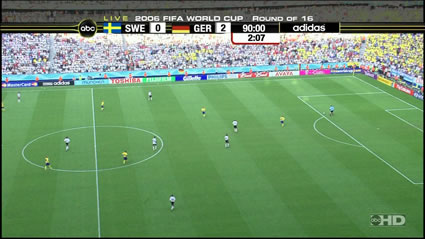
Scrutinize the tactics of the soccer teams. Is one team hunkered down in their own goal box just going for the draw? Is the team that’s winning stalling the game, taking their time when the ball goes out of bounds? Are they trying to keep possession of the ball rather than go forward? Do they keep possession of the ball and slowly work up the field or do they send a long ball up to the forwards? For one thing, the best teams do a bit of both. Watch how teams defend. Do they play an off-side trap and move the defensive line up the field or play deeper and more compact near their goal? Do they double team one player when he receives the ball? Are they stretched or organized? Good teams play compact defense and close down as a unit. Observe the speed of play. Good teams also vary and control the pace of the game. A few short passes and then a long pass that splits the defense and puts a teammate through with a chance on goal. Great teams play the ball at speed – sharp passes, driven balls, and whipped in crosses. Pay attention to how momentum changes games. They often say the first five minutes and last five minutes of each half are key moments of the game. Don’t concede an early goal and then look for a late goal when the other team is tired. Teams pounce on other teams just after they score. Momentum is a key factor, when you have it seize it, when you don’t, fight to win it back. Hard work will solve a number of ills in soccer. Feel out the emotional level of the teams. Are the teams playing with energy and being aggressive or sitting back – is one team intimidated? Maybe the home team plays more freely than a team on the road. Watch how each 50/50 ball is challenged for. Sometimes a fight and challenge for a ball is a thing to appreciate. As two players jump up into the air to head the ball to a teammate amongst two defenders, an elbow to the face in the process. Listen to when the fans cheer, sing and whistle. Listen to their national anthems. See how the crowd sings, jumps, claps and stands nearly the whole game. Delight in the goal celebrations. A goal is hard to come by and a player can be overcome with emotion and deservedly so. A run to the bench to celebrate, a dance, sliding on their chest towards where their fans are located, ripping off the jersey and revealing an under shirt with a message on it, and so on. Ideally, you want to see live soccer games… See Live Games Go see games. Whether it’s a college or professional game. It’s hard to really get a feel for the speed of play, physicality or hear the talk and chatter that’s a part of a high level live game unless you see it in person. If you can’t go see a live soccer (football) game you can still learn a lot from watching games on television. Nowadays, there are a number of bars that show soccer and stations like ESPN, beIN SPORTS, NBC, Fox Soccer, Gol TV, and Setanta show soccer nearly twenty four hours a day. History of the Ball on Television When you think of a soccer ball, you probably imagine a classic black-and-white paneled ball. It’s known as the Telstar ball, and it was created thanks to TV. The 1966 World Cup in England was broadcast live across the globe and it was at this point that television became a huge part of the sport. Thanks to the BBC, it was seen by four hundred million people. But spotting the ball was a bit challenging.Back then, soccer balls looked more like reddish-brown volleyballs. And on black-and-white TVs, it didn’t really stand out from the green field. By the 1970 World Cup, the soccer ball had changed to that classic Telstar. The contrasting panels made it stand out on TV. Plus, the players loved it because the 32 panels brought the ball closer to an actual sphere. This year’s World Cup ball is called the Telstar 18, a nod to the original design. While the panels have changed to just six propeller-shaped pieces to make the ball even more spherical, the black-and-white checkered design is back. Raise Your Soccer Game – Learn More: |
Watch Soccer on TV















